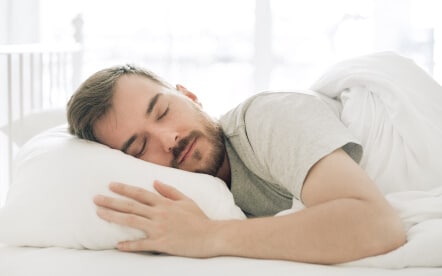A normal sleep pattern
The cycle of sleeping and waking that a person experiences within a 24-hour period is referred to as the sleep pattern. You can read about what we consider to be a normal sleep pattern in this article.
A healthy sleep pattern
Most adults sleep seven to eight hours a day. Some need less, others need up to ten hours of sleep or more. That is partly genetically determined.
We follow a normal sleep pattern when we sleep at night and stay awake during the day, which is the case for most people around the world. If we want to live in harmony with our biological clock, we must maintain a consistent sleep rhythm every day, thus preventing any disruption to our sleep pattern.
In fact, it doesn’t matter if the sleep period takes place at night or during the day, as long as it’s at the same time every day. So night workers who always go to sleep at the same time during the day need not be concerned. Those who work alternately in day and night shifts may suffer from a disturbed sleep pattern.
The stages of our sleep
Those who maintain a good sleep pattern give their body the opportunity to go through the different stages of a healthy sleep. The main distinction is made between REM sleep (1 phase) and non-REM sleep (4 phases). During the night, we go through four or five cycles of the four stages of sleep.
Sleep phase 1: falling asleep
- takes an average of five minutes
- we float between waking and sleeping
- the eyes close, brain activity decreases
- conscious reactions are still possible
Sleep phase 2: light sleep
- takes about half an hour
- we are asleep, but not yet deep
- we cease to react to every sound
Sleep phase 3: transition phase to deep sleep
- takes about five minutes
- breathing becomes regular and deeper
- heart rhythm drops to 40 to 50 beats per minute
- muscles relax
Sleep phase 4: deep sleep
- usually takes almost 20 minutes
- body undergoes physical rest and recovers
- if we wake up in this, we are confused and drowsy
Sleep phase 5: REM sleep
- takes about a quarter of an hour
- muscles are completely relaxed
- high level of brain activity
- heart rhythm and breathing are irregular
- blood pressure rises
- we constantly make eye movements (hence the name rapid eye movement)
- this is the phase in which we dream
A good sleep pattern by age
The demand for sleep is primarily a personal trait, but it also changes as we age. Babies sleep a lot and at irregular times. Their sleep patterns also change often. Children are already starting to develop a regular sleep pattern. As we age, the need for sleep decreases slightly, and our average sleep pattern may shift slightly.
A disturbed sleep pattern
Many people today have an irregular sleep pattern, which can have a negative impact on health. A disturbed sleep pattern can lead to medical and psychological problems after as little as six months.
A person who doesn’t adhere to a typical sleep pattern with the standard day-night cycle suffers from a circadian rhythm disorder. We can divide this irregular sleep pattern into four distinct types:
- Delayed sleep phase disorder: people who fall asleep very late every night (at 4 a.m. or later) and only wake up late in the day (around noon, for example)
- Early sleep phase disorder: people who fall asleep too early (sometimes as early as 7 p.m.) and then wake up in the middle of the night and can no longer sleep
- Broken sleep pattern: people who take short naps throughout the day and never get a good night’s sleep
- Freerunning type: people who go to bed a little later every day and get up a little later

Influence of the bed on the sleep pattern
The phases of sleep can be influenced by the quality of the bed. The body recovers during the deep sleep phase, but that is only possible when the muscles are completely relaxed. For this, sufficient support must be provided to the back and neck, otherwise, the muscles will instinctively tense up to alleviate the spine.
A Dorsoo sleep system guarantees a better quality of sleep and thus contributes to a good sleep pattern. Thanks to the even pressure distribution of the bed base and the comfortable mattress, the muscles can fully relax, allowing uninterrupted sleep without waking up due to pain stimuli. We have a quiet night and wake up refreshed and fit in the morning.


